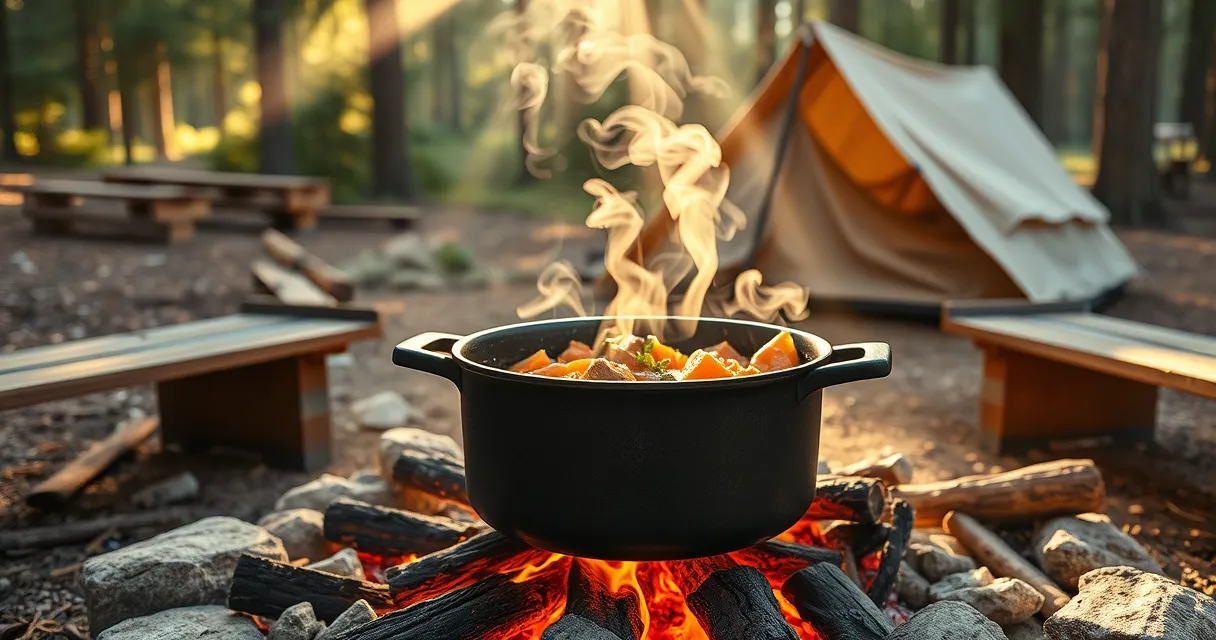Camp stew is the ultimate comfort food for outdoor lovers and home cooks in the South. It’s a hearty meal made with simple ingredients. It’s perfect for campfires, family meals, and quick dinners.
This dish comes from Alabama and is loved in Southern cooking. It mixes tender meats, savory veggies, and strong spices. You can make it in a Dutch oven, slow cooker, or instant pot. It stays true to its classic taste no matter how you cook it.
The best thing about camp stew is how easy it is to make. It’s great for feeding many people with little effort. It’s a favorite at barbecues and camping trips, loved by all ages.
Key Takeaways
- Camp stew is a versatile Southern comfort food
- Adaptable to multiple cooking methods
- Perfect for outdoor and indoor meal preparation
- Combines simple ingredients with rich flavors
- Traditionally rooted in Alabama culinary culture
What Makes Alabama Camp Stew a Beloved Comfort Food
Alabama camp stew is a treasured dish in Southern cooking. It started as a simple meal for outdoor gatherings. Now, it’s a comfort food that brings families together with its rich flavors and cultural value.
The history of camp stew goes back to hunting camps in the South. Hunters and outdoor lovers mixed meats and veggies into a tasty pot.
Cultural Roots and Significance
Camp stew is closely tied to Brunswick stew, another Southern favorite. These dishes are more than food. They stand for community, sharing, and being resourceful.
- Originated in rural hunting camps
- Developed as a way to use multiple meat sources
- Became a staple at community gatherings
Traditional Ingredient Composition
Classic Alabama camp stew has shredded pork and chicken at its heart. This mix gives it a unique flavor that makes it stand out.
“Camp stew is more than a recipe – it’s a culinary tradition passed down through generations of Southern families.”
Regional Variations
Each Southern state has its own camp stew twist. Though the main ingredients stay the same, local tastes and traditions add their own flair.
The lasting love for Alabama camp stew shows how a simple dish can unite people. It connects us through shared meals and traditions.
Essential Equipment for Making Perfect Camp Stew
Cooking camp stew needs the right tools for great taste. Whether at home or by a campfire, the right cookware makes a big difference.
- Huge Black Iron Pot: The classic choice for real outdoor cooking, great for campfire cooking
- Dutch Oven: Durable and versatile, perfect for both indoor and outdoor use
- Slow Cooker: Easy for home cooking with little effort
- Instant Pot: A modern way for quick and efficient meals
A dutch oven is the top pick for camp stew. Its thick walls and heavy build spread heat evenly, making dishes rich and flavorful. Cooking over a campfire in a huge black iron pot adds a true outdoor touch to the stew’s taste.
At home, a slow cooker is handy for easy and consistent results. The Instant Pot is a modern option, cooking faster while keeping flavors complex. Each method adds something special to the stew, fitting different cooking places and tastes.
Pro tip: Pick your cooking gear based on where you cook and what you have.
Camp Stew Recipe: Step-by-Step Cooking Instructions
Making the perfect camp stew requires careful prep and focus. This recipe combines hearty ingredients and rich flavors. It’s ideal for both campers and home cooks seeking a satisfying meal.
Ingredient Preparation Techniques
Before starting, it’s crucial to prepare your ingredients correctly. You should:
- Dice vegetables into small, even pieces
- Cube meat for even cooking
- Shred any pre-cooked proteins like chicken or pork
Cooking Process Timeline
The camp stew cooking method involves several key steps. These steps help build deep flavors:
- Brown the meat in a large pot
- Add diced vegetables
- Pour in tomato sauce and beef broth
- Simmer until the meat is tender
Tips for Perfect Consistency
To achieve the right camp stew texture, manage your liquids well. Adjust the beef broth to avoid a too thick or too thin stew. Start with less broth and add more as you cook.
| Ingredient | Preparation Method | Quantity |
|---|---|---|
| Beef | Cube | 1 pound |
| Vegetables | Dice | 2 cups |
| Tomato Sauce | Pour | 1 cup |
| Beef Broth | Add gradually | 2-3 cups |
“The secret to great camp stew is patience and layering flavors.” – Southern Cooking Traditions
Slow Cooker and Dutch Oven Adaptation Methods
Adapting your camp stew recipe for a slow cooker or Dutch oven is exciting. Each method has its own benefits for making this classic dish.
Slow cookers and crock pots are great for busy cooks. They cook at a low temperature, making flavors rich and saving time. When using a slow cooker, layer ingredients to cook evenly and avoid sticking.
- Prepare meat first by searing for extra flavor
- Add vegetables in order of cooking time
- Use low heat setting for tender results
- Keep lid closed during cooking process
Dutch ovens use traditional cooking with even heat. Their cast iron keeps temperatures steady, making flavors deep and complex.
| Cooking Method | Cooking Time | Temperature |
|---|---|---|
| Slow Cooker | 6-8 hours | Low (195°F) |
| Dutch Oven | 2-3 hours | Medium (325°F) |
Choose your method, but keep the heat steady. Let ingredients slow cook and blend together perfectly.
Instant Pot Camp Stew: Modern Cooking Technique
The instant pot has changed home cooking, making it faster and easier. It’s great for making hearty meals, like camp stew. It’s perfect for outdoor lovers and busy cooks.
With pressure cooking, you can make delicious camp stew quickly. A 6 quart instant pot is big enough for big batches of this favorite dish.
Pressure Cooking Time Guidelines
Cooking camp stew in an instant pot needs the right timing and method. Here are some key tips for perfect pressure cooking:
- Meat preparation: Brown meats using the sauté function before pressure cooking
- Cooking time: Typically 25-30 minutes for most meat combinations
- Liquid ratio: Ensure sufficient broth or stock for proper pressure cooking
Safety Tips for Pressure Cooking
Mastering pressure cooking means knowing important safety tips:
- Always check the sealing ring for damage before cooking
- Use the quick release method carefully to prevent steam burns
- Ensure the valve is in the correct position before starting
“Pressure cooking is an art that combines speed with culinary precision” – Professional Chef
The instant pot is great for making tasty camp stew with little effort. By using the right techniques, you can get restaurant-quality results at home.
Key Ingredients and Possible Substitutions
Making the perfect camp stew means knowing its key ingredients and how to mix things up. Pulled pork is usually the main protein, but canned meat is a quick swap for those in a hurry.
The classic camp stew has ingredients that have been loved for generations. These include:
- Pulled pork (primary protein)
- Lima beans for texture and nutrition
- BBQ sauce for depth of flavor
- Worcestershire sauce for umami complexity
- Cornbread for serving
Want to change up the recipe? Vegetarians can use jackfruit or plant-based meats instead of pulled pork. For those watching their salt, low-sodium BBQ sauce or homemade sauces are good options.
| Original Ingredient | Potential Substitution |
|---|---|
| Pulled Pork | Shredded Chicken, Jackfruit, Tofu |
| Lima Beans | Butter Beans, Cannellini Beans |
| BBQ Sauce | Homemade Tomato-Based Sauce |
Pro tip: Always taste and adjust seasonings when making substitutions to maintain the camp stew’s signature flavor profile.
“The beauty of camp stew is its versatility – there’s no single right way to make it!” – Southern Cooking Enthuasiast
Serving Suggestions and Side Dish Pairings
Enhancing your camp stew experience is more than just cooking. The right sides and presentation can turn a basic meal into a memorable outdoor dining event. Whether you’re cooking on an open fire or at home, the right choices can make your camp stew stand out.
Traditional Accompaniments
Classic pairings highlight the flavors of camp stew. Warm cornbread muffins soak up the rich flavors, adding a delightful texture. Dinner rolls are another classic side that can make your camp stew feel like a full feast.
- Cornbread muffins with a touch of butter
- Crisp dinner rolls
- Pickled vegetables
- Simple green salad
Modern Pairing Ideas
Modern camp stew lovers are trying new things. Adding Tabasco and corn gives it a cool twist. Here are some fresh pairings to update the classic recipe:
| Pairing | Flavor Profile |
|---|---|
| Jasmine rice | Mild, aromatic base |
| Artisan sourdough | Tangy, crusty complement |
| Roasted vegetable medley | Hearty, nutritious addition |
When cooking outdoors, how you serve your meal is fun. Serve your camp stew in sturdy cast-iron skillets or enamel camp dishes. A sprinkle of fresh herbs or a dollop of sour cream can make it special.
Storage Tips and Leftover Ideas
Keeping your camp stew fresh is easy. Just store it right to enjoy it for days. The secret is in how you handle the leftovers.
Here’s how to store your camp stew:
- Cool the stew completely before storing
- Use an airtight container to prevent flavor loss
- Refrigerate within two hours of cooking
- Store in the refrigerator for up to 3-4 days
Freezing is a great way to keep your stew longer. Pro tip: Freeze it in portions. This makes reheating simple and saves food.
Reheating your stew needs some care to keep it tasty. You can reheat it two ways:
- Stovetop: Warm over medium-low heat, stirring occasionally
- Microwave: Use a microwave-safe container and heat in short intervals
Be creative with your leftover stew. Here are some ideas:
- Use as a filling for savory pot pies
- Top baked potatoes with warmed leftover stew
- Create a hearty sandwich spread
- Use as a base for a quick casserole
With the right storage and reheating, your leftover camp stew can become new, tasty meals.
Troubleshooting Common Camp Stew Issues
Making the perfect camp stew takes practice and patience. Even skilled cooks face challenges. Knowing how to fix common problems will help you make a tasty meal every time.
Solving Texture Inconsistency Problems
Getting the right texture is key for a great camp stew. If it’s too thick, add warm broth or water slowly while stirring. For a thinner stew, simmer it uncovered to reduce liquid and intensify flavors.
- Use cornstarch slurry to thicken quickly
- Mash some vegetables to naturally improve texture
- Adjust cooking time to reach desired thickness
Mastering Seasoning Techniques
Getting flavors right is all about kosher salt and pepper. Start with a little red pepper flakes for heat. Taste and adjust seasonings slowly to avoid too much.
- Layer seasonings throughout cooking process
- Use fresh herbs for depth of flavor
- Let stew rest to allow seasonings to meld
Quick Fixes for Cooking Method Challenges
Different cooking methods have their own problems. Slow cookers can have uneven heat, while Dutch ovens might scorch. Stir often and watch the temperature to avoid these issues.
Pro tip: Always use low and slow cooking techniques for the most tender camp stew.
Recipe Variations for Different Dietary Needs
Camp stew is for everyone, no matter their diet. You can make it vegetarian, vegan, gluten-free, or low-sodium. It’s very flexible.
For vegetarians and vegans, try different proteins. Use:
- Jackfruit for a meaty texture
- Textured vegetable protein (TVP)
- Lentils or mixed beans
- Plant-based meat substitutes
For gluten-free diets, use cornstarch or arrowroot powder. They keep the stew thick and tasty.
| Dietary Requirement | Recommended Substitution |
|---|---|
| Vegetarian | Jackfruit or mushroom medley |
| Vegan | Plant-based protein crumbles |
| Gluten-Free | Cornstarch thickener |
| Low-Sodium | Herb blend instead of salt |
| Keto-Friendly | Cauliflower base, high-fat meats |
Keto-friendly versions use low-carb ingredients. Use zucchini, cauliflower, and high-fat proteins. This follows keto diet rules.
To make it low-sodium, use herbs, citrus zest, and spices. Fresh herbs like thyme, rosemary, and sage add flavor without salt.
Conclusion
Camp stew is a classic comfort food. It turns simple ingredients into a delicious meal. It connects families across generations with its rich flavors and easy preparation.
The best part about camp stew is how flexible it is. You can make it over a campfire, in a slow cooker, or with an Instant Pot. It lets you add your own twist, making it a dish that everyone can enjoy.
Every pot of camp stew has its own story. It’s about Southern gatherings and outdoor adventures. It’s more than food; it’s about tradition and shared moments. By trying new things, you can make it your own.
We invite you to dive into the world of camp stew. Learn about its history and make your own tasty memories. With a little practice, you can become a master of this beloved dish that brings people together.
FAQ
What is the difference between Alabama Camp Stew and Brunswick Stew?
Alabama Camp Stew and Brunswick Stew are similar one-pot meals. But, they have some differences. Alabama Camp Stew often has pulled pork and chicken in a tomato-based BBQ sauce. Brunswick Stew, on the other hand, can vary a lot. It might include different meats and vegetables, depending on where you are.
Can I make Camp Stew if I don’t have a campfire?
Yes, you can! Camp Stew is easy to make at home. You can use a slow cooker, Dutch oven, or Instant Pot. These methods let you enjoy this comfort food without needing a campfire.
What are the essential ingredients for a traditional Camp Stew?
Traditional Camp Stew has shredded pork, pulled chicken, tomato sauce, and BBQ sauce. It also includes lima beans, corn, and seasonings like Worcestershire sauce. The recipe can change based on where you are and your family’s traditions.
How long can I store leftover Camp Stew?
Leftover Camp Stew can stay in the fridge for 3-4 days. If you want to keep it longer, freeze it for up to 3 months. Always heat it up well before eating.
Can I make a vegetarian version of Camp Stew?
Yes! You can swap out the meat for plant-based proteins like jackfruit, tofu, or tempeh. Keep the tomato sauce and veggies to keep the taste just right.
What are the best side dishes to serve with Camp Stew?
Cornbread muffins, dinner rolls, and coleslaw are top picks. Some folks also enjoy it with white rice or crusty bread for dipping.
How can I adjust the seasoning in my Camp Stew?
To tweak the flavor, add hot sauce, red pepper flakes, or more Worcestershire sauce. Start small and taste as you go. This helps you avoid over-seasoning.
What cooking method is best for making Camp Stew?
Each method has its perks. Slow Cooker is simple, Dutch Oven adds depth, Instant Pot cooks quickly, and campfire cooking brings smokiness. Choose what works best for you.








